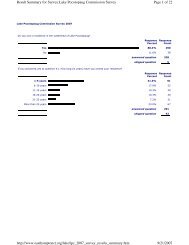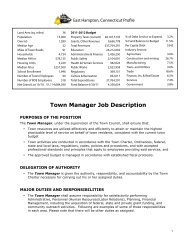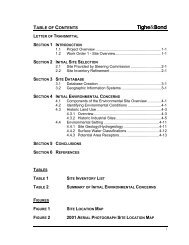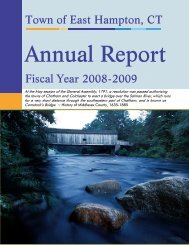Lake Pocotopaug Lake and Watershed Restoration Evaluation ...
Lake Pocotopaug Lake and Watershed Restoration Evaluation ...
Lake Pocotopaug Lake and Watershed Restoration Evaluation ...
Create successful ePaper yourself
Turn your PDF publications into a flip-book with our unique Google optimized e-Paper software.
6.0 WATER QUALITY6.1 In-<strong>Lake</strong> Water QualityTemperature <strong>and</strong> DO profiles at the two in-lake stations during April-November 2001 arepresented in Figure 7. Other water quality data are summarized in Table 10. Values recordedbelow the detection limit are reported as ½ the detection limit. 2001 in-lake values for eachsampling <strong>and</strong> a summary of all data (previous reports <strong>and</strong> 2001 data) are provided in AppendixB.Thermal stratification occurs when sunlight warms the upper waters but wind mixing isinsufficient to mix this warmer water all the way to the bottom of the waterbody. This is a naturalprocess, but has distinct implications for lake ecology, as the lower water layer can be a refugeor a detriment depending on how much oxygen is present. <strong>Lake</strong> <strong>Pocotopaug</strong> was beginning tothermally stratify in April 2001 <strong>and</strong> was almost destratified by September. The thermocline waspresent at five meters at LP-1 <strong>and</strong> at six meters at LP-2 in May. The thermocline dropped to 5.5<strong>and</strong> 6.5 meters at LP-1 <strong>and</strong> LP-2, respectively, come July <strong>and</strong> dropped another 0.5 meters inAugust. These results indicate that <strong>Lake</strong> <strong>Pocotopaug</strong> is a typical dimictic water body (twocomplete mixing events in spring <strong>and</strong> fall separated by summer thermal stratification).Oxygen stratification roughly followed thermal stratification (Figure 7). DO readings below thethermocline were often less than 1.0 mg/L. DO below 1.0 mg/L was recorded above thethermocline at both stations (6 <strong>and</strong> 7 meters, respectively) in August. Anoxic conditions werealso recorded above the thermocline in June 2000 (VLSG 2001). DO readings of less than 6mg/l, undesirable for many aquatic life forms, were never recorded at depths above 5 m.Turbidity is a measure of water clarity. Turbid waters are indicative of high levels of suspendedparticles that may include algal cells, silt, or resuspended sediments <strong>and</strong> are usually associatedwith poor water quality. Acceptable st<strong>and</strong>ards depend on water body use, but turbidity readingshigher than 10 nephalometric turbidity units (NTU) are indicative of potentially undesirable waterquality. Most “clean” New Engl<strong>and</strong> lakes exhibit turbidity ranging from 1 to ~5 NTU. Maximumturbidity in <strong>Lake</strong> <strong>Pocotopaug</strong> surface water exceeded the 5 NTU threshold at LP-2 (5.2 NTUrecorded in August), but averages were below 5 NTU (2.8 <strong>and</strong> 2.7 NTU, Table 10).Turbidity was higher near the sediment-water interface. Settling particles accumulating in thedeeper areas of the reservoir were likely responsible, though accidental stirring of finesediments by the sampling procedure could have contributed to the higher readings.The pH varied little in time <strong>and</strong> space during the 2001 sampling (Table 10). pH ranged from 6.1to 8.5 SU, with the lower values measured near the bottom <strong>and</strong> the high values near thesurface. Mean pH ranged from 6.6 to 7.4 SU.<strong>Lake</strong> <strong>Pocotopaug</strong> <strong>Restoration</strong> <strong>Evaluation</strong> 29May 2002







